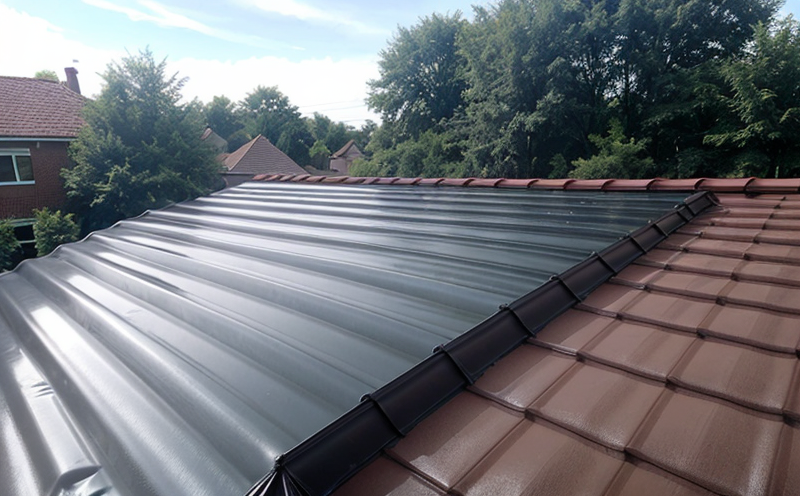ISO 12572 Water Vapour Transmission of Roofing Materials
The ISO 12572 standard is a comprehensive test protocol designed to measure the water vapour transmission (WVTR) properties of roofing materials. This property is crucial in determining how effectively a roof can resist moisture ingress while still allowing for the passage of water vapor, which is essential for preventing condensation and maintaining indoor comfort.
The test method involves placing a specimen between two chambers with controlled humidity levels. One chamber is maintained at 100% relative humidity (RH), while the other is kept at a lower RH level, creating a gradient across the material. This setup allows water vapor to pass through the material from the humid side to the dry side.
The rate of this water vapor transmission is measured over time and expressed as grams per square meter per day (g/m²/day). The test provides valuable information for quality managers, compliance officers, R&D engineers, and procurement teams involved in selecting roofing materials that meet specific performance criteria.
Testing according to ISO 12572 helps ensure that the roofing material selected will perform optimally under various climatic conditions. It is particularly important for buildings where moisture management is critical, such as commercial structures, residential buildings, and industrial facilities.
The testing process typically involves preparing a specimen of the roofing material according to specified dimensions. Once prepared, the specimen is placed in a testing chamber with controlled humidity levels. The apparatus used includes sensors to monitor temperature and relative humidity at both sides of the sample, ensuring accurate measurement of water vapor transmission.
The results from this test are vital for understanding how well the roofing material can prevent moisture-related issues while allowing necessary vapor diffusion. This knowledge is essential for designing roofs that enhance energy efficiency by reducing heating costs due to reduced condensation and improving indoor air quality.
Scope and Methodology
The ISO 12572 standard outlines a precise methodology for determining the water vapor transmission rate of roofing materials. The scope covers various types of roofing materials, including membranes, coatings, and composite systems, used in construction to achieve optimal thermal and moisture management.
- Material Types: Membranes, coatings, composite systems
- Test Environment: Controlled humidity chambers with adjustable levels
- Sensors for monitoring temperature and relative humidity
- Data Collection: Continuous measurement of water vapor transmission over time
The testing procedure begins by conditioning the specimen under specified conditions to ensure consistency. The specimen is then placed between two chambers, one at 100% RH and the other at a lower RH level. Water vapor diffuses from the humid side to the dry side through the material.
Data collection involves continuous monitoring of both sides' humidity levels and temperature throughout the test duration. The rate of water vapor transmission is calculated based on these measurements, providing an accurate assessment of the roofing material's WVTR properties.
Industry Applications
| Application Area | Description |
|---|---|
| Commercial Buildings | Ensuring proper moisture management to enhance energy efficiency and indoor air quality. |
| Residential Buildings | Avoiding condensation issues that can lead to mold growth and structural damage. |
| Industrial Facilities | Preventing water vapor accumulation in critical areas where it could affect operational safety. |
| Retrofitting Existing Structures | Evaluating the effectiveness of new roofing materials for enhancing moisture performance without extensive structural changes. |
- Energy Efficiency: Reduces heating costs by minimizing condensation and maintaining optimal indoor temperatures.
- Mold Prevention: Ensures that water vapor can escape, reducing the risk of mold growth inside buildings.
- Safety Compliance: Meets regulatory standards for moisture management in construction projects.
These applications highlight the importance of ISO 12572 testing in various sectors where proper moisture control is essential. By adhering to this standard, contractors and builders can ensure that their roofing materials perform optimally under diverse climatic conditions.
Why Choose This Test
Choosing ISO 12572 testing for your roofing materials is essential for several reasons:
- Compliance with Standards: Adherence to international standards ensures that the chosen materials meet industry best practices and regulatory requirements.
- Predictive Performance: The test provides insights into how the material will perform in real-world conditions, aiding in selecting the most suitable product for specific applications.
- Enhanced Durability: By understanding the WVTR properties of roofing materials, you can select products that are more durable and less prone to damage from moisture-related issues.
- Sustainability: Proper moisture management leads to energy-efficient buildings, reducing environmental impact and operational costs.
In summary, ISO 12572 testing is a critical tool for ensuring the long-term performance and sustainability of roofing materials. It helps in making informed decisions that contribute to better building envelopes and enhanced occupant comfort.





